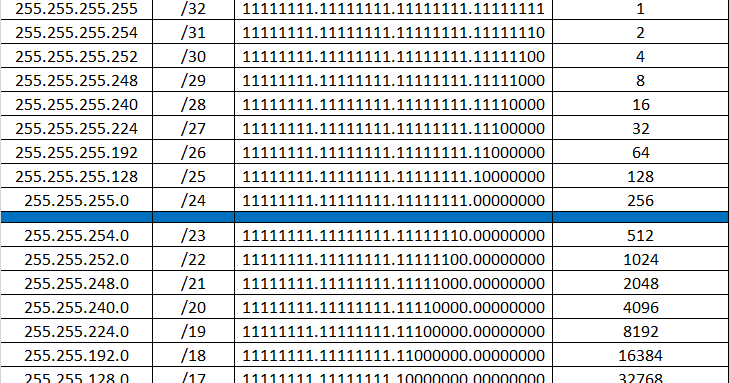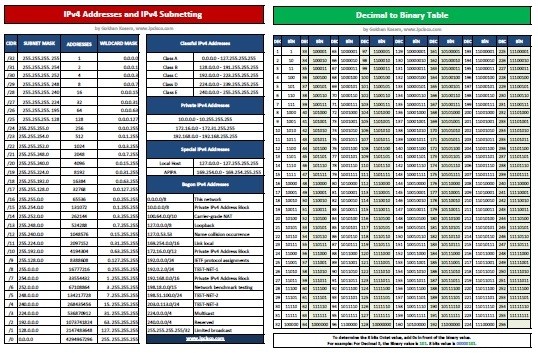

- #NETWORK SUBNET MASK TABLE HOW TO#
- #NETWORK SUBNET MASK TABLE UPDATE#
- #NETWORK SUBNET MASK TABLE PLUS#
- #NETWORK SUBNET MASK TABLE WINDOWS#
A persistent route stays in place even when Windows starts up. But if you’re just adding one or two static routes that you don’t expect to change often, you can instead just add the -p option to the command to make the route persistent. You could certainly use the batch script method yourself.
#NETWORK SUBNET MASK TABLE HOW TO#
RELATED: How to Write a Batch Script on Windows This keeps the routing table relatively uncluttered. Rather than adding and updating all those routes on every machine, they just distribute a batch script file that adds the newest routes during Windows startup. The reason for this is that many companies use a coordinated list of static routes that gets updated fairly often.

When you add a static route, by default it only lasts until the next time you start Windows. That’s all easy enough, but there is one extra little catch.

Unless you’ve already added static routes to the table, everything you see here will be dynamically generated. You’ll see a long list of network destinations and the gateways to which packets are forwarded when they are headed to that destination. RELATED: How to Put the Command Prompt Back on the Windows+X Power Users MenuĪt the Command Prompt, type the following command and hit Enter: route print
#NETWORK SUBNET MASK TABLE PLUS#
You can do pretty much everything in PowerShell that you can do in Command Prompt, plus a lot of other useful things. It’s very easy to switch back to showing the Command Prompt on the Power Users menu if you want, or you can give PowerShell a try.
#NETWORK SUBNET MASK TABLE UPDATE#
Note: If you see PowerShell instead of Command Prompt on the Power Users menu, that’s a switch that came about with the Creators Update for Windows 10. Fire up Command Prompt by hitting Windows+X and then selecting “Command Prompt (Admin)” on the Power Users menu. Thus, for example, 207.61.16.119/24 signifies 207.61.16.119/255.255.255.0.Before you get started adding routes, it may be helpful to view the routing table first. They append a suffix of the form /n to the host’s IP address to indicate the subnet mask, in which n equals the number of binary 1s in the subnet mask. Some TCP/IP configuration programs, such as those for Ascend routers, use a different notation for specifying subnet masks. The table also shows how these subnet masks would partition an IP address such as w.x.y.z into a network ID and a host ID portion.ĭefault Subnet Masks for IP Addresses Class Default Subnet Mask Network ID Host ID A 255.0.0.0 w x.y.z B 255.255.0.0 w.z y.z C 255.255.255.0 w.x.y z Ascend routers The default subnet masks for IP address classes A, B, and C are shown in the following table.

Two types of subnet masks are used in TCP/IP networking: Taking the logical NOT of the subnet mask and ANDing it with the host’s IP address gives the host’s Host ID: Host = 11001111 00111101 00010000 01110111 Converting these two numbers to binary and ANDing them gives the host’s Network ID: Host = 11001111 00111101 00010000 01110111 When the inverse of the subnet mask (for example, NOT mask) is logically ANDed with the IP address of the host, the result is the host ID of the host – the portion of the host’s IP address that uniquely identifies the host on its network.įor example, consider the IP address 207.61.16.119 and the subnet mask 255.255.255.0. When the subnet mask is logically ANDed with a 32-bit IP address of a TCP/IP host, the result is the network ID of the host – the portion of the host’s IP address that identifies which network the host is on. In binary notation, decimal 0 represents the octet 00000000, and decimal 255 represents 11111111.Ī subnet mask consists of 32 binary digits, the first n of which are 1s and the remaining of which are 0s. Subnet masks are represented as four-octet dotted-decimal numbers, just as IP addresses are, except that the most common values for an octet in a subnet mask are 0 and 255.


 0 kommentar(er)
0 kommentar(er)
